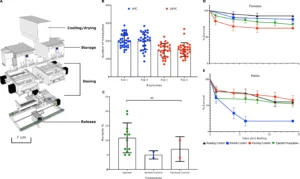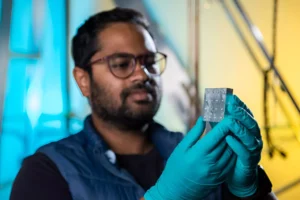In the landscape of pharmaceutical development, the synthesis of new chemical compounds is an essential step toward providing innovative therapeutic options. Among these, azetidines—a class of four-membered rings containing nitrogen—have risen to prominence due to their medicinal properties. Traditionally, creating azetidines has proven daunting compared to their five-membered nitrogen counterparts, which are prevalent in many
In today’s culinary landscape, the air fryer has surged into our kitchens, hailed as a wonder tool for quick, crisp meals that promise healthier alternatives to traditional frying methods. With an intuitive interface and seemingly effortless operation, the air fryer has pushed the boundaries of convenience in cooking, making it an essential appliance. But what
Over the past two decades, the Amazon basin has experienced devastating droughts that have drastically changed the landscape of its communities and ecosystems. A recent study conducted by the Institute of Environmental Science and Technology at Universitat Autònoma de Barcelona (ICTA-UAB) reveals alarming statistics about the increasingly severe impacts of climate change on this vital
Sleep is not merely a passive state of rest; it is an essential component of healthy living, especially during adolescence when brain development experiences significant changes. For teenagers aged 9 to 14, quality sleep goes beyond just feeling refreshed; it is a fundamental pillar that supports cognitive functions, emotional health, and overall well-being. However, despite
In a landmark moment for the shipping industry, the Pyxis Ocean embarked on an unprecedented journey in August 2023—a nearly 25,000 km voyage from the bustling port of Shanghai to the southern Brazilian port of Paranaguá. This five-year-old cargo vessel did not solely rely on traditional, pollutive bunker fuel for propulsion. Instead, it embarked on
In California, the emblematic image of landslides often coincides with storm seasons. Torrential rain saturates the soil, causing the intricate connection between soil and rock to weaken and ultimately collapse. While these dramatic occurrences yield plenty of public discourse, less attention is directed toward the subtler, almost covert landslides that occur during the drier months.
Dark matter remains one of the most elusive and enigmatic components of our universe, occupying a significant portion of its mass yet remaining invisible. For researchers, the journey to detect dark matter is akin to wandering in an unlit room, trying to find an object by only feeling its presence, as any direct observation of
In the vast expanse of our galaxy, certain celestial phenomena challenge our understanding of the universe, and among them stands the neutron star SGR 0501+4516, categorized as a magnetar. These extraordinary objects are defined by their extreme magnetic fields, which dwarf typical neutron stars, making them the most potent magnets known in the cosmos. Recent
This week, the astronomy community is abuzz with excitement as we celebrate the 35th anniversary of the Hubble Space Telescope’s launch. Rather than waiting for gifts, the Hubble team has chosen to share its cosmic treasures with the world, providing stunning images of celestial phenomena that continue to captivate our imaginations. Launched aboard the space
Radionuclides, with their unpredictable behaviors and potential health repercussions, enter the human body through a variety of channels, including inhalation and ingestion or even through open wounds. Once inside, these radioactive elements provoke a silent yet formidable threat to our health. While extensive research has focused on animal models to assess the risks of radionuclide
Age-related macular degeneration (AMD) has long been a leading cause of vision impairment and blindness among individuals as they age. The damage inflicted upon the macula, located in the retina, results in detrimental effects on vision quality, leading to blurred images and severe limitations in daily life. Although there are existing treatments that can slow
In today’s world, the presence of microplastics is becoming an alarming norm, infiltrating our environments, food sources, and even our bodies. These tiny plastic particles, often less than 5 millimeters in size, are generating concern among researchers, particularly regarding their potential impact on human health. Recent studies have unveiled a troubling correlation between microplastics and
In the realm of quantum electronics, a revolutionary development has emerged, promising to reshape our understanding of electronic devices through the innovative manipulation of kink states. Researchers from Penn State have spearheaded this pioneering work, revealing that imperfections—namely, kink states—may hold the key to enhanced control within quantum systems. These kink states, which act as
Rogue waves have long plagued maritime endeavors, striking fear into the hearts of sailors and offshore workers. Characterized as large, unexpected waves that can rise abruptly, they pose significant risks to ships and platforms. The unpredictability of these waves has historically left seafarers vulnerable to hazardous conditions at sea. However, a groundbreaking study published in
In an era increasingly shaped by infectious diseases, understanding the dynamics of respiratory droplets is not just academic; it’s a matter of public health. Recent advancements in scientific experimentation shine a vital light on how far our spittle can travel and how this impacts the spread of infectious agents. Research has embarked on a journey















